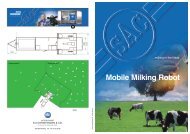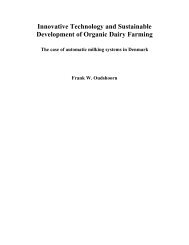Validation of Calibration Equations Developed ... - Automatic Milking
Validation of Calibration Equations Developed ... - Automatic Milking
Validation of Calibration Equations Developed ... - Automatic Milking
You also want an ePaper? Increase the reach of your titles
YUMPU automatically turns print PDFs into web optimized ePapers that Google loves.
was determined with low uncertainty. In spite <strong>of</strong> these results the prediction intervals <strong>of</strong> the<br />
equations, and example predictions made with the equations, indicated that there could be<br />
great uncertainty about the future predictions (Hansson 2011). The aim <strong>of</strong> this report is to<br />
validate the calibration equations developed in the master thesis by Hansson (2011). In<br />
relation to the aim the following question is addressed: How precise are the predictions<br />
made by the calibration equations found in the Master’s thesis by Hansson (2011)<br />
Precision is in this report used to describe how close the predicted yield is to the actual yield<br />
and is expressed through: 1) the mean distance between predicted and actual yield in the<br />
statistical data analysis and 2) the percentage <strong>of</strong> predictions that are within ±10% <strong>of</strong> the<br />
actual yield.<br />
2 Materials and methods<br />
The data used for validation <strong>of</strong> the calibration equations were collected in a field trial at the<br />
research facilities <strong>of</strong> the Faculty <strong>of</strong> Agricultural Sciences at Aarhus University, Denmark. The<br />
trial was conducted in 2009 as a part <strong>of</strong> the grazing project “Grazing – also a part <strong>of</strong> the<br />
future cattle production 1 ”. The data was used by Hansson (2011) but not in the development<br />
<strong>of</strong> the calibration equations.<br />
2.1 Equipment<br />
The herbage samples cuts, made to determine the pasture yield in kilo dry matter per<br />
hectare (kg DM/ha), was cut with either a Haldrup harvester or a modified sheep shearing<br />
machine. The Haldrup harvester is a green mass harvester for experimental use, with a<br />
cutting width <strong>of</strong> 150cm. The height samples in millimetres (mm) were made with a CPM<br />
which measures height by infrared light. The tunnel shaped machine has rails with 18<br />
sensors mounted on the inside. The sensors are placed 20mm apart staring from ground<br />
level and send/receive infrared light; as a light beam is obstructed is additional height<br />
registered. For more detailed information see manufacturer’s webpage: http://www.cdax.co.nz.<br />
1 Danish title on the project: Afgræsning – også en del af fremtidens kvægbrug<br />
5




